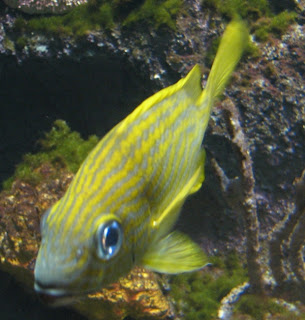A reef is a pretty noisy place to live. One family of fish, the grunts, get their name from the grunting noise they make by grinding their pharyngeal teeth. Grunts are pretty, deep-bodied fish that are generally found traveling in schools. The French grunt (Haemulon flavolineatum) has yellow stripes on a silver background or blue stripes on orange.
 |
| The French grunt (Haemulon flavolineatum) |
Wrasses are a large group of fish that are well represented on the reef. Most are small, averaging about 9 inches (23 cm) long, with cigar-shaped bodies, pointed snouts, and prominent canine teeth. During the daytime wrasses feed, and at night they hide in crevices or buried in sand. Wrasses feed in several ways, depending on their species.
 |
| Wrasses |
The cleaner wrasses remove mucus, parasites, and scales from the bodies of larger fishes. Another species exhibits “following behavior” to find prey. As larger fish swim through the substrate and disturb it, these wrasses follow closely, picking up invertebrates that the large fish overlook. A different species of wrasses searches the reef for invertebrates too small for most fishes to prey upon. Finally, some wrasses flip over rocks and pieces of coral with their snouts, looking for hidden invertebrates. There are more species of gobies on the reef than any other kind of fish. These small animals, which measure less than 2 inches (5 cm), have prominent eyes set high on their heads.
Gobies spend most of their time hiding among rocks, corals, or shells. Some make their homes inside of other living things like sponges and the shells of mollusks, and a few share burrows with shrimp.
 |
| Gobies |
The peacock flounder (Bothus lunatus) is a reef flatfish that usually hides in the sand and sediment on the reef floor. Like other kinds of fish, the peacock flounder begins life with bilateral eyes and a mouth in the middle of its face; however, as the fish matures, one eye begins to migrate toward the other one so that by maturity both eyes and the mouth are located on one side of the head. Peacock flounders do not have swim bladders, so they sink to reef floor and remain there, often wriggling around enough to bury their bodies in the sand with just their eyes and gill opercula exposed. The skin of a peacock flounder is covered with brown spots, but can change colors to camouflage the fish.
 |
| The peacock flounder (Bothus lunatus) |
